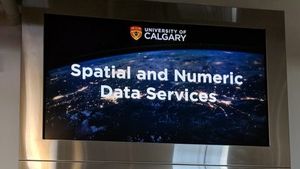Libraries have invested significantly in name authority work over the years, and have created extensive infrastructure to help manage names of people and organizations. The relationship between this work and broader interest in this topic is something that will need to be addressed in coming years if this work is to continue to have utility.

Library authority work is now doubly partial: it is organized on national lines, and it typically only applies to names which come forward in the ‘cataloged’ literature (not in the journal literature, for example). We are working with several national libraries on the VIAF project to address the former issue. The latter may end up requiring various partnerships and mappings as other approaches get established, but this is in very early days. More generally, if library authority files are to be of greater use, it seems inevitable that national libraries will need to coordinate more closely in creating and sharing them, and they will have to open up more to a variety of contributions (should I, for example, be able to augment the authorities data held about me?). It is also probably sensible to consider adding references to author or contributor IDs as they emerge in other contexts.
To simplify, think of three ‘current materials workflows’ which libraries manage in different ways, and which result in access services: (i) materials that are cataloged, typically bought materials like books, where the metadata is managed and sometimes created by the library (ii) materials that are licensed, typically the journal and A&I literature, where the metadata is created, and aggregated, by many external third parties who may not follow common practices with regard to the form of names, and (iii) institutional research and learning outputs, typically e-prints, data or learning materials, where the metadata may be created by academics or by the library, and where the potential value of an agreed regime for the formation of personal and institutional names is only beginning to emerge.
(One place where this lack of consistency is becoming increasingly apparent in libraries is in the new ‘discovery layer’ systems which are bringing the catalog, local digital materials, and maybe knowledge base and metasearch into a single discovery environment.)
Library approaches have historically dealt with (i).
There is now major interest in the other areas, and this interest seems to have grown recently.
In (ii) above see for example ResearcherID from Thomson or the Scopus Author ID.
For an example under (iii) see how the Digital Author Identifier is used by the institutional repository framework in the Netherlands. This is interesting because it does in fact work with library authority files.
Digital Author Identification (DAI) is a unique national number assigned to every author who has been appointed to a position at a Dutch university or research institute or has some other relevant connection with one of these organisations. SURF and OCLC PICA have set up a link with the PICA thesaurus of personal names that is maintained and updated by the university libraries. One very important factor in this system is the link between the Metis research information system and the repository. …
…. An application used in NARCIS (the portal into which DAREnet has been integrated since April 2008) allows Open Access publication lists to be generated on the basis of the DAI harvested from the various repositories of Dutch scientific/scholarly institutions. Using the DAI, it is possible to present the information from the various repositories in an integrated manner. [Digital Author Identifier (DAI)]
At the same time, there is a variety of disciplinary or community approaches. See for example the RePEc Author Service.
The interest in names and author IDs is driven by several factors. Services want to disambiguate authors and to cluster works by the same author. Increasingly, personal and institutional reputation management in a web environment is focusing attention on identifiers and consistent naming. This is especially the case as metrics based on citations and web links become more common.
For some useful context on this topic see this note by Geoff Bilder and also see the landscape report [pdf] from the Names project in the UK, an initiative exploring the feasibility of a name authority service for repositories of research outputs.



